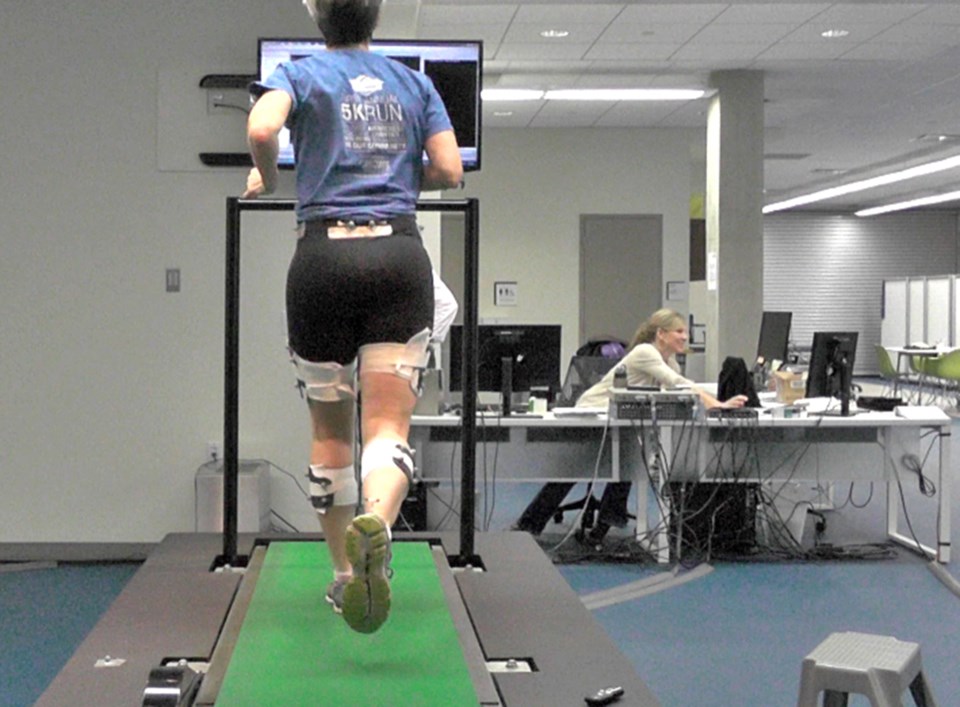For 14 weeks, NOW health reporter Cornelia Naylor has been assigned to undertake a “Fortius challenge,” setting fitness and performance goals and experiencing first-hand the many ways Burnaby’s Fortius Sport & Health can help.
As a rehab project, the team will zero in on a lingering shoulder injury, but Naylor will also get a chance to sample everything else Fortius has to offer, from massage therapy to diet advice and from vision testing to a scientific analysis of her running gait.
Here’s her fourth report:
I’m back at the Fortius Sport & Health lab to find out whether my running style might be behind a certain cement-mixer feeling in my hips.
Lab and applied biomechanics director Christopher MacLean greets me with an eight-page report and large, flat-screen TV projecting an image of me running on a treadmill in tight, high-waisted shorts.
The image and the data in the report were captured a week before.
I had come into the lab, and MacLean and biomechanist Jessica Maurer had stuck reflectors on different parts of my feet, legs, knees and hips.
The lab-issued shorts (so tight, so high-waisted) had ensured the markers wouldn’t move relative to the bone underneath.
I had then run on a treadmill as four video and 10 motion-capture cameras recorded my movements and a force plate built into the treadmill measured my footfalls.
“We kind of look at the lower extremity like it’s sandwiched between the ground and your centre of mass, which is in your core,” MacLean says during our follow-up interview.
Every time our feet hit the ground, he explains, forces travel upward from the ground and downward from our core.
At different phases of our running gait, those forces can total two-and-a-half times our body weight, and our bodies have to find ways to manage them by rotating in different ways and absorbing the force.
MacLean’s job is to help people manage and prevent injury by scouring data from walking, running and jumping analyses for evidence of structural weaknesses and maladaptive movement patterns.
While I’m running, for example, MacLean says the angles between my femur and pelvis are greater all around on my right side compared to my left.
That could mean muscle weakness, a lack of flexibility or just a troublesome quirk of my running style.
My hip-extension angle when I “toe off,” meanwhile, is less than it should be on both sides.
None of these things is visible to the human eye, but they could be what’s behind the hip and knee pain, according to MacLean.
“Five degrees can be quite clinically relevant here because it can have a huge effect on the forces, which is what we’re really interested in because that’s likely what causes the injuries,” he says.
His recommendations include physio and work with a strength and conditioning coach.
But there’s another problem with my running that I can start to fix on my own.
Like many recreational runners, my stride is too long, according to MacLean, something that stresses the knees and hips.
Rather than shortening my stride, however, he recommends increasing running “cadence,” something that tends to cut down step length naturally.
An optimal stride frequency for distance runners is about 180 steps per minute, MacLean says; mine is about 160.
Narrowing that gap is simple: download a playlist of songs at 180 beats per minute and run to it.
Viola!
After about six to eight running sessions over a two- to three-week period, MacLean predicts my body will adjust to its new running rhythm.
Besides preventing future stress on my knees and hips, he says there is a chance it might even address some of my current issues without physio.
“I’ve seen some of these pelvic asymmetries resolve just with increased cadence,” he says.
Running style, including cadence, has long been on the radar of elite runners, many of whom come to the Fortius lab to find ways to manage injuries and optimize performance.
But recreational athletes have never had much access to that know-how and technology.
Fortius is trying to turn that around.
Because of the centre’s philanthropic model, MacLean says his clients now include not only elite athletes, but also ordinary people, whose goals range from running the Vancouver Sun Run to walking the dog three times a week.
Toward that end, the lab has kept the price of a running analysis for Fortius clients to $180 – roughly the price of a good running shoe.
Follow Cornelia’s journey at www.burnabynow.com.



